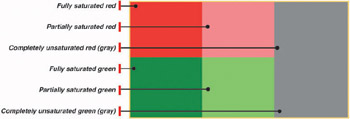Work with Color and Calibration
There are enumerable ways to describe particular colors. These are called color models, or color spaces. The computer primarily uses the RGB color space. RGB stands for Red, Green, and Blue. Every color on your computer monitor is created by mixing together different amounts of red, green, and blue light. Printers and photographs, on the other hand, generally exist in the CMYK color space. CMYK stands for Cyan, Magenta, Yellow, and blacK. Most color printing, whether on your desktop printer or a large commercial press, is done using these four colors of ink.
| Note | History information is not saved with your files. |
RGB and CMYK color spaces differ quite fundamentally. RGB is additive. It creates new colors by adding together red, green, and blue light. Red light plus green light plus blue light equals white light. The more light you add, the brighter the color gets.

| Tip | To revert to the last saved version of a file, choose File and then select Revert. The file is reloaded from disk and any changes made since the last save are discarded. |
CMYK on the other hand is subtractive. It creates colors by subtracting colors from white. Cyan ink plus magenta ink plus yellow ink equals black. In printing, white is (usually) the complete absence of ink on the paper. The more ink you add, the darker the color gets.

On your computer monitor, a photo of a red ball is red because your monitor is actually emitting red light. However, a red ball, sitting in your driveway, is red because the ball absorbs every color of sunlight except red, which it reflects.
The problem of getting RGB images created on the computer to look the same when printed out in CMYK ink is a difficult one. We’ll look at it in more detail in Chapter 8.
Work with Hue, Saturation, and Luminance
The other color model you will use most often in Photoshop is Hue, Saturation, and Luminance.
Hue is what most people think of as the basic color. Is it reddish or greenish? The difference between red and blue is a difference of hue.
Saturation is a measure of how intense a color is versus how much white is mixed with it. The difference between red and pink is a difference of saturation. White, gray, and black have no saturation at all.

Luminance is how bright a color is. The difference between white and black is a difference of luminance.
Calibrate Your Monitor
The first step in creating work that can be reproduced accurately either on a printer or on another monitor is to calibrate your own monitor.
The Adobe Gamma application is installed when you install Photoshop. Use the Adobe Gamma application to calibrate your monitor in Windows.
-
From the Windows desktop, click Start, select Settings and then Control Panel.
-
Double-click the Adobe Gamma icon to start Adobe Gamma.
-
Click Step-by-Step (Wizard), and then click Next.
-
Follow the steps seen to calibrate your monitor and save a new monitor profile.

EAN: 2147483647
Pages: 59